 |
Hampsthwaite - St Thomas Becket |
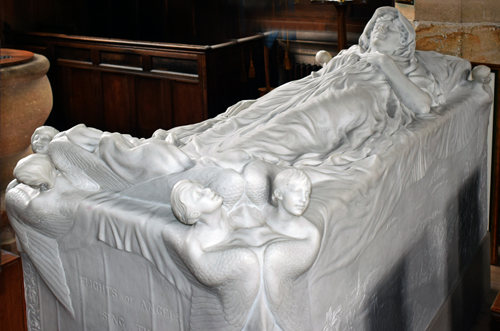 |
 I wonder were these portraits of real children |
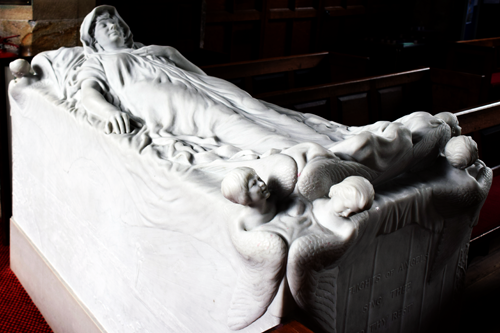 |
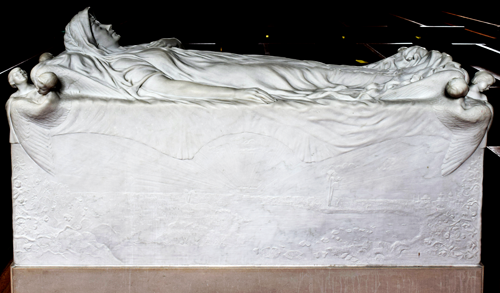 |
 |
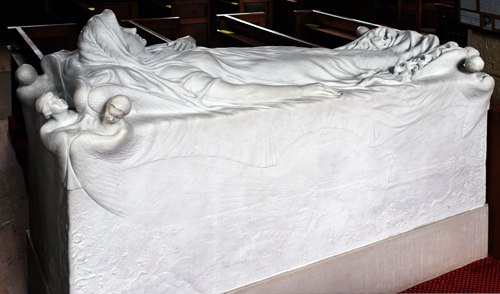 |
| Amy
Woodforde-Finden (1919) White marble by George
Wade. It is said to have been designed by Judini.
The angels look rather like portraits of 20th century children:
perhaps they were. Note the (difficult to see) relief on the tomb chest. Composer, born in Chile of American parents as Amelia Rowe Ward but became a British citizan. Buried in the church yard. Her husband was a surgeon and brigadier with the delighful name of Woodforde Woodforde-Finden |
||
 |
 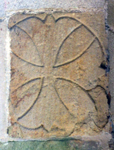 |
THE PORCH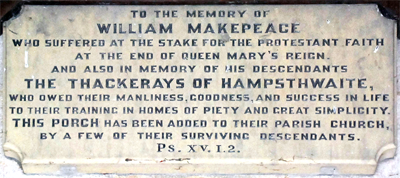 Cross slabs used to line the porch The above modern tablet refers to the building of the church porch. I cannot find a reference to this event in Foxe's Book of Martyrs but this cannot be complete and there may be some local history and knowledge of which I am unaware. |
 |
 |
 |
| Thomas Atkinson AB (1737) Vicar fro 27 years His wife, Alice (1738) |
Edward Greenwood (1798) | Rev Henry Dark MA (1898) Vicar for 36 years Signed: Leeds Marble Co |
| Other Monuments |
| Mary Crosby (Ingle) (1825)
Aged 24; buried at Overton, near York. White sarcopagus like
tablet with feet on black base John Swale (1909) Wooden tablet records the clock was placed in the tower in his member. Rev Joseph Wilson BA (1810). Vicar. His wife, Mary (1806), and their only son, Bilton Josephus Wilton (1869) and his wife, Sarah (1869). White tablet in Gothick frame |
| Harewood - All Saints |
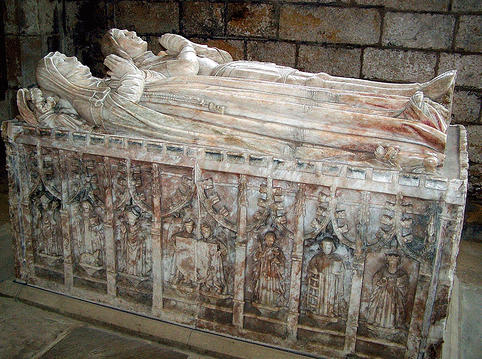 |
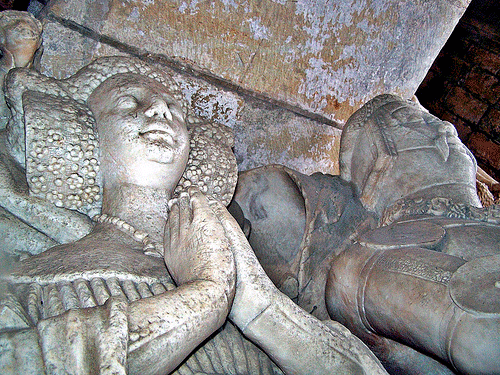 |
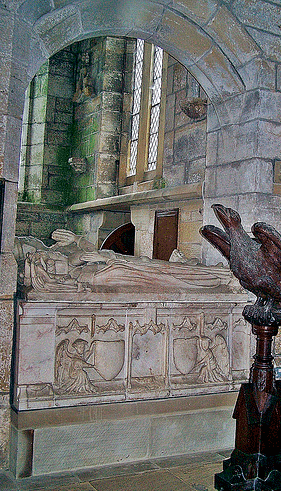 |
| Above
left:Sir Richard Redman or Redmayne
(1475) & Margaret (Middleton)
Alabaster/
This Sir Richard Redman was grandson and heir of the Sir Richard
Redman below. Above right and far right: Sir Richard Redman or Redmayne (1426) & Elizabeth (Aldburgh), his second wife; his third wife was Elizabeth, daughter of Chief Justice William Gascoigne and Elizabeth (Mowbray) Alabaster. |
||
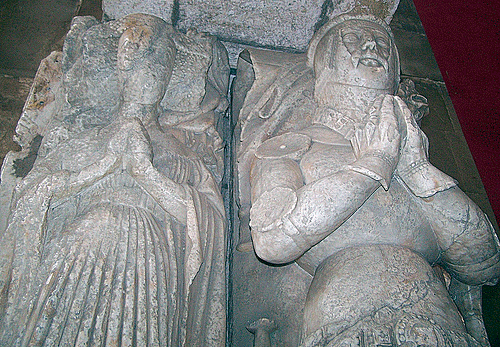 |
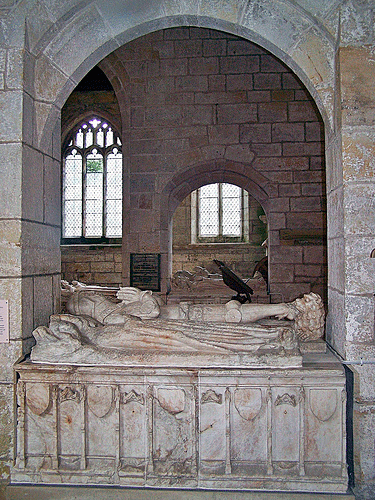 |
Sir William Ryther (1426) & Sybil (Aldburgh) (1440) Alabaster. Similar to the Redmayne effigies of similar date (above) |
 |
 |
| Chief Justice William Gascoigne (1419) & Elizabeth (Mowbray) (1391) Alabaster |
 |
 |
| William Gascoigne (1454) & Margaret (Clarell) (1465) William was the grandson of William Gasgoigne and Elizabeth Mowbray. Alabaster |
 Thwaites Brass indent |
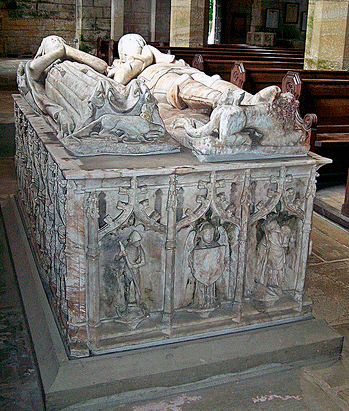 |
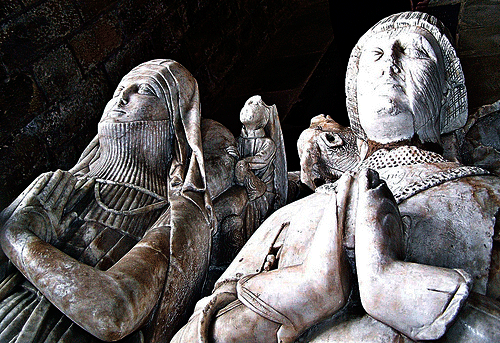 |
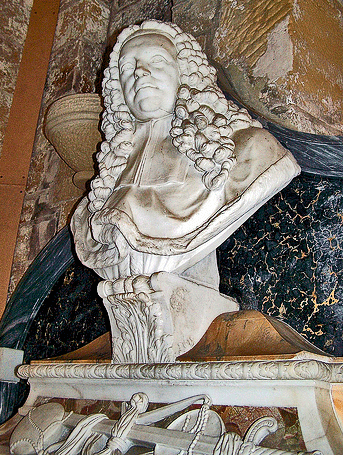 |
| Left and above: Sir William Gascoigne (1487) & Margaret Percy. He was the grandson of William Gascoigne & Margaret Clarell; she the 4th daughter of Henry Percy, 2nd Earl of Northumberland. Alabaster | Sir Thomas Denison (1765) by N. Hedges A judge who wished to be buried near Chief Justice Gascoigne |
| Harrogate - St Mary |
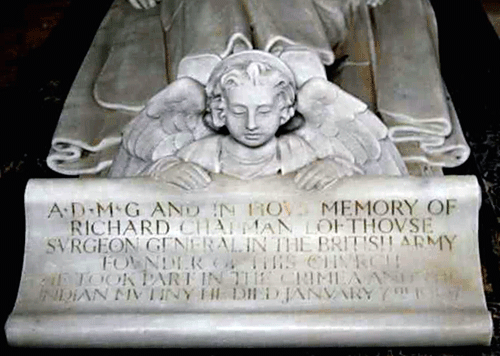 |
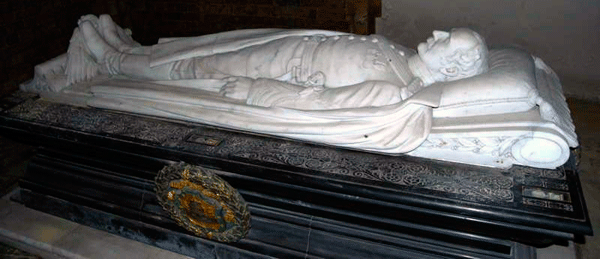 |
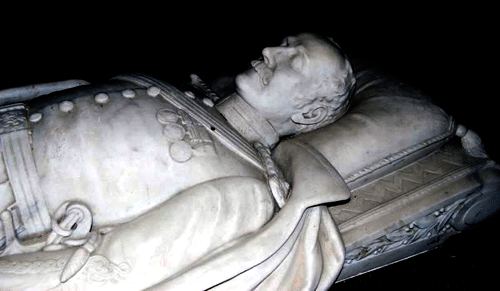 |
|
Richard Chapman Lofthouse
(1832-1907)
Surgeon-General in the British Army and founder of the
church, which is no longer in use. Photograph taken by Kenneth Paver and used by grateful permission. |
||
| Haworth - St Michael and All Angels |
| The Brontë Family Church |
 |
 |
 |
The Brontës are buried in a vault beneath the church - with the exception of Anne (1820-1849) who died Scarborough and was buried in St Mary's church yard there. The central photograph above is a memorial to members on the family who are buried in the church: Maria Brontë (Branwell) (1783-1821), wife of the Rev Patrick Brontë; their daughters who died young, Maria (1814-1825) and Elizabeth (1815-1825). The sister-in-law of the Rev Patrick Brontë, Elizabeth Branwell (1776-1842). Children of The Patrick and Maria who lived to adulthood: Patrick Branwell Brontë (1817-1848), Emily Jane Brontë (1818-1848), Charlotte Nicholls (Brontë) (1816-1855). Finally the Rev Patrick Brontë (1777-1861) Charlotte married her father's curate Arthur Bell Nicholls in June 1854 and later became pregnant. She died with her unborn child in March 1855. |
||
|
|
|||||||||
 |
Horbury - St Peter & St Leonard |
 |
 |
 |
 |
 |
 |
| Robert Carr (1760) and his
wife, Rose (Lascelles) (1774). Architect |
Lt Col James Spawforth (1824) | Robert Craven (1829) and his wife, Ann (1831); also his brother and sister: Sarah Craven (1839) and William Craven (1842) | Sarah (1769), wife of William Craven; and his second wife, Elizabeth (1790). Also the aforementioned William Craven (1804), Wool ſtapler | Harriet Elizabeth Carr (1841) Who died of scarlet fever at 14 The yougest daughter of John Francis Carr and Mary (Robinson) |
| The church was designed by John Carr, who paid for its construction; he was a son of Robert Carr, above. He is buried in the church but there appears to be no monument except the church itself. |
| Kirkby Malham - St Micheal |
| Not interesting to the art historians but to those interested in the War of the Three Kingdoms, the Commonwealth and Protectorate |
 |
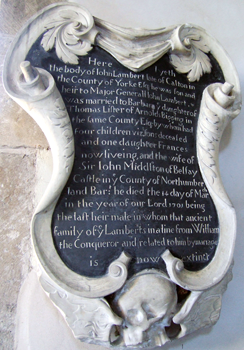 |
 Above: Brass to the grandson of Major General John Lambert - also, John Lambert, who died in 1676 in his fifth year. Left: Monument to John Lambert (1701), father of the above and son of the Major General. The text is given below. Far Left: General John Lambert (1684) Details below. Modern tablet Right: Jane and Joshua Waddingtonn (1673). Brother and sister: he 12 and she 6 years. Brass. |
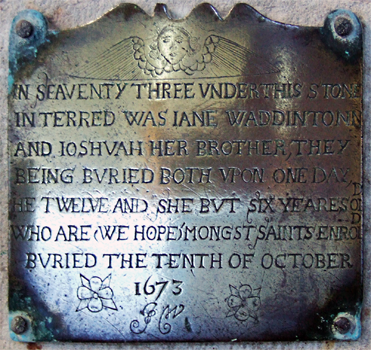 |
| Major General John Lambert |
John Lambert (1619- 1684) was an English Parliamentary General and politician. He was born in Colton Hall, Kirkby Malham in the West Riding of Yorkshire.  Early
in the first stage of the
War of the Three Kingdoms, he was an active commander
in the northern campaigns, playing a notable part in the Battle
of Marston Moor. By 1645 he was temporarily in charge of the
Northern Army when Sir Thomas Fairfax went south and before the
appointment of Sydenham Poyntz.With the war ended in the north,
in Jan. 1646 Lambert given Montague’s regiment of foot (after
the latter resignation) in the New Model Army and served in the
closing stages of the campaign in south-west England. He was
prominent in army politics and in summer 1647 was sent
north to restore order and to command the Northern Army.
He played an important part in the second civil war, ensuring
the security of Yorkshire, containing Scottish-royalist forces
in Cumberland and Lancashire and, having joined Cromwell,
prominent in the battle and wider campaign of Preston. Early
in the first stage of the
War of the Three Kingdoms, he was an active commander
in the northern campaigns, playing a notable part in the Battle
of Marston Moor. By 1645 he was temporarily in charge of the
Northern Army when Sir Thomas Fairfax went south and before the
appointment of Sydenham Poyntz.With the war ended in the north,
in Jan. 1646 Lambert given Montague’s regiment of foot (after
the latter resignation) in the New Model Army and served in the
closing stages of the campaign in south-west England. He was
prominent in army politics and in summer 1647 was sent
north to restore order and to command the Northern Army.
He played an important part in the second civil war, ensuring
the security of Yorkshire, containing Scottish-royalist forces
in Cumberland and Lancashire and, having joined Cromwell,
prominent in the battle and wider campaign of Preston.In 1650-51 was Major-General and second-in-command to Cromwell in the invasion of Scotland, providing the tactics and leading the attack and victory at Dunbar and also leading the assault at Inverkeithing in summer 1651 which enabled Cromwell to throw most of his army across the Firth of Forth. His further activity in pursuit of the Scottish-royalists and in the battle and wider campaign of Worcester confirmed his military skill. He did not take part in the trial of King Charles, nor did he sign the death warrant, being in the North of England at this time. Political advance followed and, as a key supporter of Oliver Cromwell and an architect of the Protectorate, his standing was probably second only to Cromwell for much of the Protectorate, until he lost his military and political offices – though not his by now extensive properties – in spring 1657 following his opposition to kingship and to the new oath of allegiance. He regained senior military command and some political standing under the restored Rump in 1659 and played the leading role in crushing the Booth Rising in Cheshire, but he was on the losing side in the brief power struggle of winter 1659-60, failing to prevent Monck moving south and taking control of events, was under arrest. He was initially imprisoned in the Tower of London, but escaped after one month in an attempt to prevent the Restoration. Unfortunately times had now changed and John Lambert, who had climbed so high, finally failed. He was sentenced to life imprisonment, initially in pleasant enough circumstances on the Island of Guernsey but finally on the not so pleasant Drake's Island in Plymouth South. He died during the winter of 1683-84 after twenty four years in prison. He was buried in St Andrew's church in Plymouth but there is now no contemporary grave or monument. |
| Insciption on Monument of John Lambert II |
Here lyeth the body of Iohn Lambert late of Calton in the County of Yorke Eſq. He was ſon and heir to Major Generall Iohn Lambert, was married to Barbara yᵉ daughter of Thomas Liſter of Arnolds Biggin in the ſame County Eſq, by whom he had four children viz 3 ſons deceaſed and one daughter Frances now liveing, and wife of Sir Iohn Middlᵉton of Belſay Caſtle in yᵉ County of Northumberlans Bart He died on the 14 day of March in the year of our Lord 1701 being the laſt heir male in whom that ancient family of yᵉ Lamberts in a line from William the Conqueror and related to him by marriage is now extinct. |
|
| Knaresborough - St John the Baptist |
 |
 |
| Above: Sir Charles Slingsby
(1869) By Boehm. Left: Francis Slingsby (1600) and his second wife, Mary (Percy) (1598). She was of the family of the Earls of Northumberland. See below for a better view of Francis. On the left wall to the side of this monument can be see that of Sir Henry Slingsby (see below). Several monuments can be seen on the right, at the foot of the Slingsby monument but I do not have further details. |
 |
 Left: Sir William Slingsby (1634) Attrib. to Epiphanius Evesham Above: Francis Slingsby (see above) Right: In the foreground are Francis and Mary Slingsby, with Mary being the more prominent. In the background the monument of Sir Henry Slingsby (1634), attrib to Epiphanius Evesham. The attitude of posing upright in a shroud was made fashionable by Nicholas Stone's monument to John Donne in St Paul's Cathedral, London |
 |
| CITY OF LEEDS |
| Leeds (Armley) - St Batholomew |
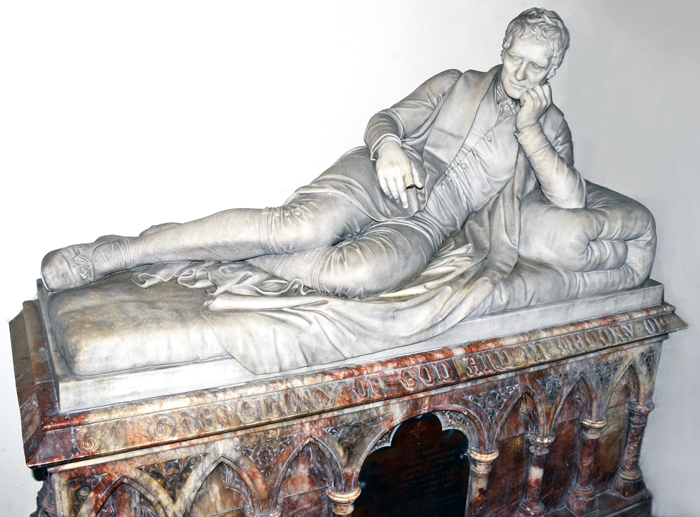 |
| Benjamin Gott (1839)
By Joseph Gott Industrialist and innovator in the textile industry |
| Leeds (Whitkirk) - St Mary |
/Viscount_Irwin_1.png) |
/Viscount-Irwin_2.png) |
/Viscount_Irwin_3.png) |
| Edward Ingram, 2nd
Viscount Irwin of Temple Newsam (1688) and his wife
Elizabeth (Sherard) (1746). At his feet is their only
daughter, Katherine who died in 1688 in her
second year. The title passed to Edward's brother , Arthur, on
his death Attributed to Talman & Pearce |
||
|
|
/Scargill_2.png) |
/Scargill_3.png) |
/Scargill_1.png) |
/Scargill_4.png) Sir Robert Scargill (1531) and Joanna (1546) Alabaster |
| Methley - St Oswald |
Other Monuments
1) Sir Robert Wateron (1424) & Wife. Alabaster effigies and very fine; tomb chest. 2) Lord Welles (1461) & First Wife. Alabaster effigies. Tomb chest. 3) A priest - effigy 4) Amale civilian - effigy The above were originally part of the same monument but now the effigies are in north and south aisles under recesses. 5) Sir John Savile (1606), his son sir Henry (1632) and his Wife. Large tomb chest with recumbent effigies. One son kneels at lady's feet. (Is this the son already referred to?) Attrib Maximilian Colt 6) Charles Savile (1741) Large base. He lolls in Roman dress and his wife sits at his feet. By Sheemakers 7) John Savile, First Earl of Mexborough (1778) Semi reclining figure by Wilton 8) Sarah, Dowager Countess of Mexborough (1821) Tablet with draped female figures, Resurrection of Lazarus below. By Westmacott 9) Tablet with female figure by urn, 1821 by R Blore of Picadilly 10) Tablet with female figure by urn, 1830 by J A C Fisher of York |
|
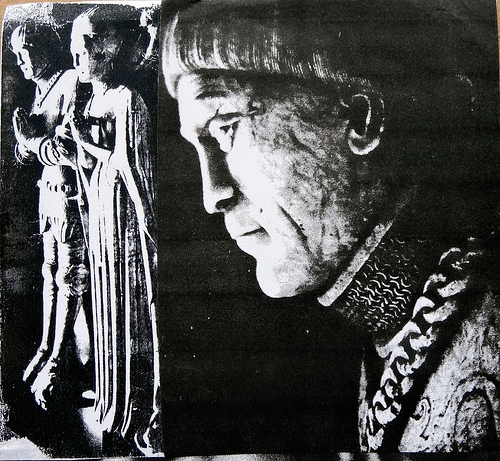
|
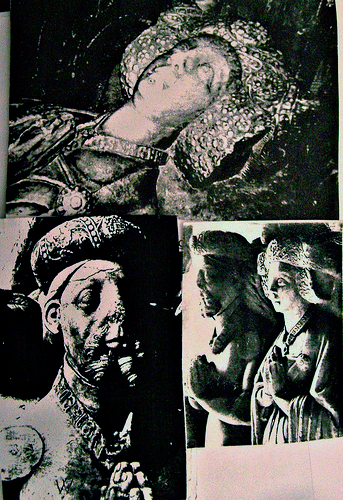 |
|
| Nether Poppleton - St Everilda |
 |
 |
 |
Above right: Anne Hutton (1651), above left: Sir Thomas Hutton (1620) The central photograph shows the two monuments in situ |
||
 |
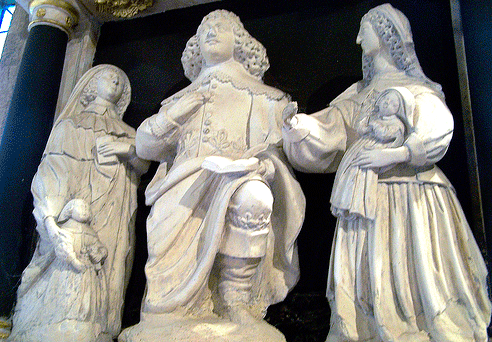 |
| Above and left: Ursula Hutton, her Husband (not named). The sources I have consulted then add, 'and a second woman' but give no further details. I cannot read the text below nor have I seen the monument. One woman holds a baby: the other a small child. |



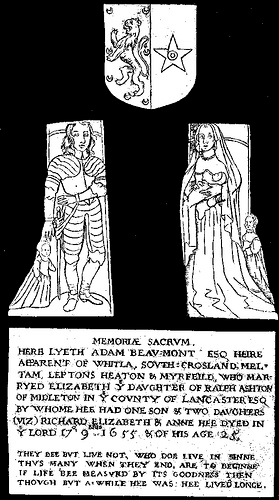
/Charles-viscount-Irwin.png)
/Gordon.png)
/John-Smeaton.png)
/Clare.png)